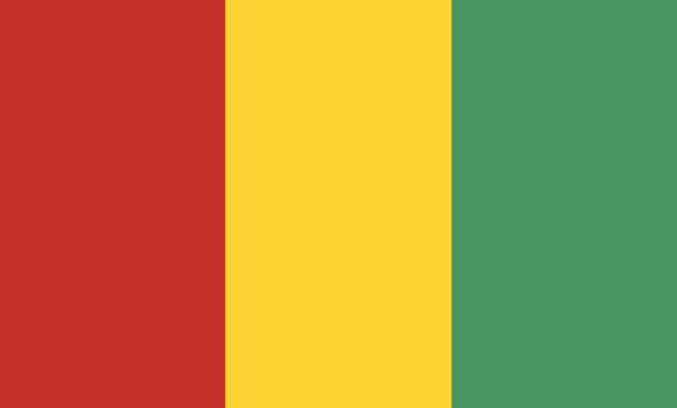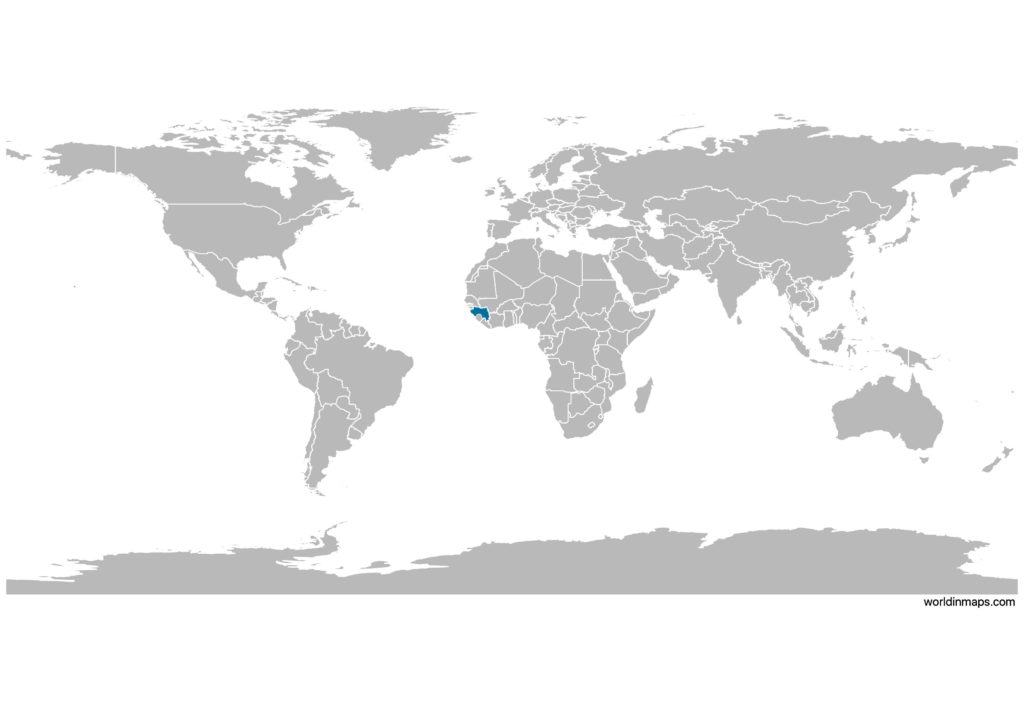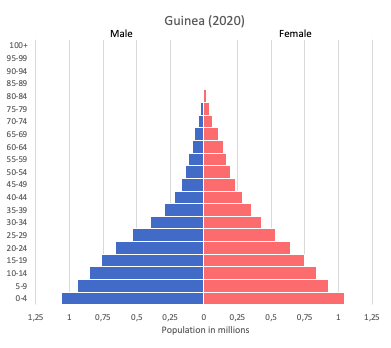Guinea

| Government | |
| Name | Republic of Guinea |
| Government type | Presidential republic |
| Capital | Conakry (1,660,973 (2014)) |
| Currency | Guinean franc (GNF) |
| People | |
| Population (2020) | 13,132,792 (77th) |
| Density of population | 40.9 P/km2 (164th) |
| Nationality | Guinean |
| Official languages | |
| French | |
| Ethnic groups (2018) | |
| Fulani (Peuhl) | 33.4% |
| Malinke | 29.4% |
| Susu | 21.2% |
| Guerze | 7.8% |
| Kissi | 6.2% |
| Toma | 1.6% |
| Other / foreign | 0.4% |
| Religions (2014) | |
| Muslim | 89.1% |
| Christian | 6.8% |
| Animist | 1.6% |
| Other | 0.1% |
| None | 2.4% |
| Life expectancy (2020) | |
| Male | 61.3 years |
| Female | 65 years |
| Total population | 63.2 years (204th) |
| Homicides | |
| n.a. | |
| Geography | |
| Land area | 245,717 km2 |
| water area | 140 km2 |
| total area | 245,857 km2 (80th) |
| Mean elevation | 472 m |
| Lowest point | |
| Atlantic Ocean | 0 m |
| Highest point | |
| Mont Nimba | 1,752 m |
| Land use (2011) | |
| Agricultural land | 58.1% |
| Arable land | 11.8% |
| Permanent crops | 2.8% |
| Permanent pasture | 43.5% |
| Forest | 26.5% |
| Other | 15.4% |
| Urbanization | |
| Urban population (2020) | 36.5% |
| Rate of urbanization | 3.54% annual rate of change (2015 – 2020) |
| Economy | |
| Labor force (2017) | 5.558 million (75th) |
| Labor force by occupation (2006) | |
| Agriculture | 76% |
| Industry | 24% |
| Unemployment rate (2017) | 2.7% (28th) |
| GDP (PPP) (estimate 2020) | |
| Total | $26.451 billion |
| Per capita | $2,390 |
| GDP (nominal) (estimate 2020) | |
| Total | $9.183 billion |
| Per capita | $818 |
| GDP by sector (estimate 2017) | |
| Agriculture | 19.8% |
| Industry | 32.1% |
| Services | 48.1% |
| Exports (2017) | $3.514 billion (123rd) |
| Exports partners (2017) | |
| China | 35.8% |
| Ghana | 20.1% |
| UAE | 11.6% |
| India | 4.3% |
| Imports (2017) | $4.799 billion (133rd) |
| Imports partners (2017) | |
| Netherlands | 17.2% |
| China | 13.2% |
| India | 11.8% |
| Belgium | 10% |
| France | 6.9% |
| UAE | 4.5% |
Guinea on the world map

Guinea top 10 largest cities (2014)
- Conakry (1,660,973)
- Nzérékoré (195,027)
- Kankan (190,722)
- Manéah (167,354)
- Dubréka (157,017)
- Kindia (138,695)
- Siguiri (127,492)
- Kissidougou (99,931)
- Labé (92,654)
- Kamsar (83,428)
Demography
Population pyramid

Age structure data
Estimate for 2020:
- 0-14 years: 41.2% (male 2,601,221/female 2,559,918)
- 15-24 years: 19.32% (male 1,215,654/female 1,204,366)
- 25-54 years: 30.85% (male 1,933,141/female 1,930,977)
- 55-64 years: 4.73% (male 287,448/female 305,420)
- 65 years and over: 3.91% (male 218,803/female 270,492)
Remark: the age structure of a population affects a nation’s key socioeconomic issues. Countries with young populations (high percentage under age 15) need to invest more in schools, while countries with older populations (high percentage ages 65 and over) need to invest more in the health sector. The age structure can also be used to help predict potential political issues. For example, the rapid growth of a young adult population unable to find employment can lead to unrest.
Population from 1950 to 2020
Source: United Nations, Department of Economic and Social Affairs, Population Division (2019). World Population Prospects 2019, Online Edition. Rev. 1.
Evolution of the life expectancy from 1960 to 2018
Source: World Development Indicators, The World Bank
Major rivers
Economy
Agriculture:
rice, coffee, pineapples, mangoes, palm kernels, cocoa, cassava (manioc, tapioca), bananas, potatoes, sweet potatoes, cattle, sheep, goats, timber
Industries:
bauxite, gold, diamonds, iron ore, light manufacturing, agricultural processing
Exports – commodities:
bauxite, gold, diamonds, coffee, fish, agricultural products
Imports – commodities:
petroleum products, metals, machinery, transport equipment, textiles, grain and other foodstuffs
Time zone and current time in Guinea
Go to our interactive map to get the current time in Guinea